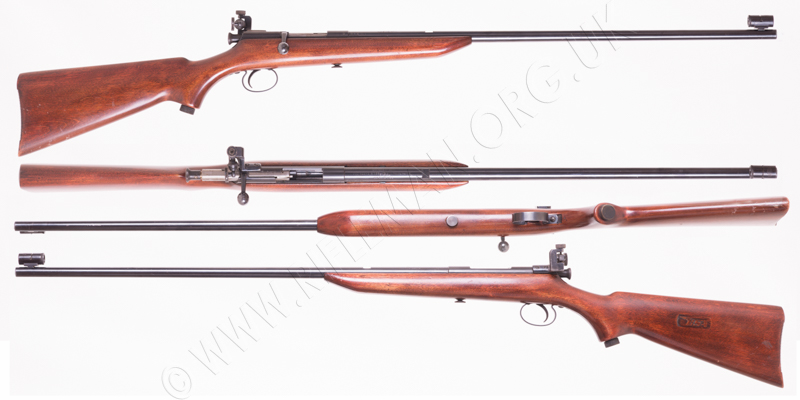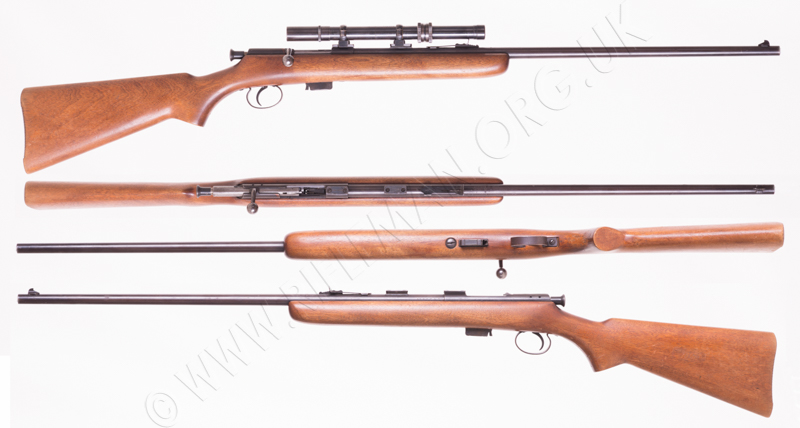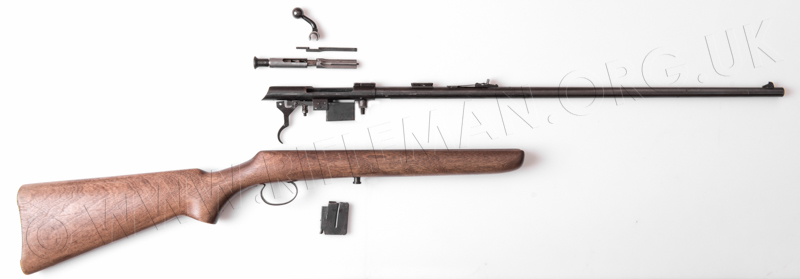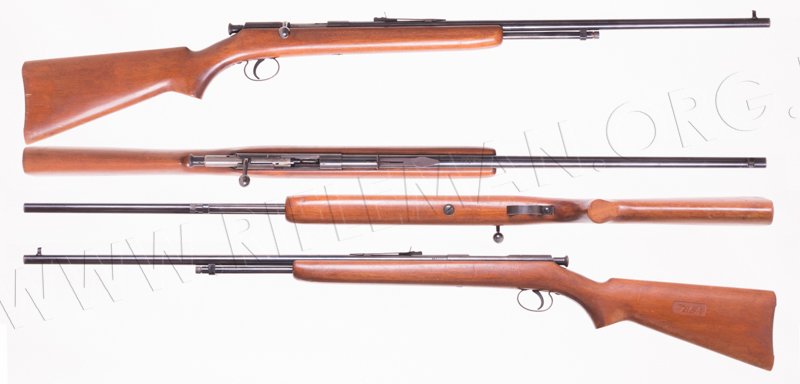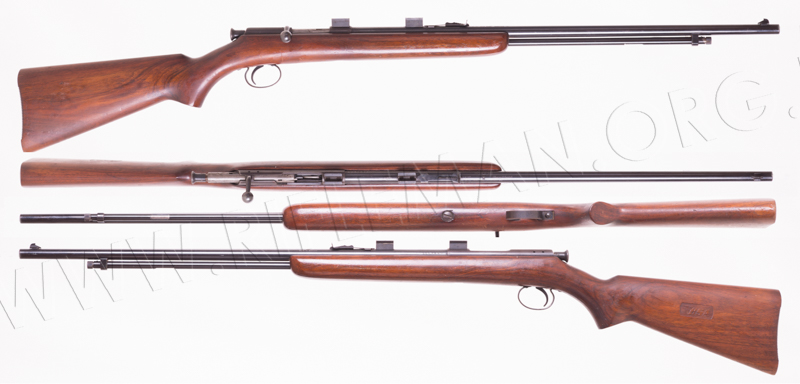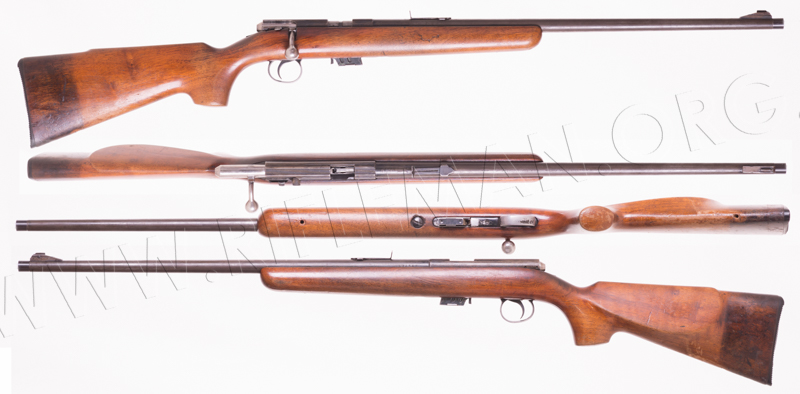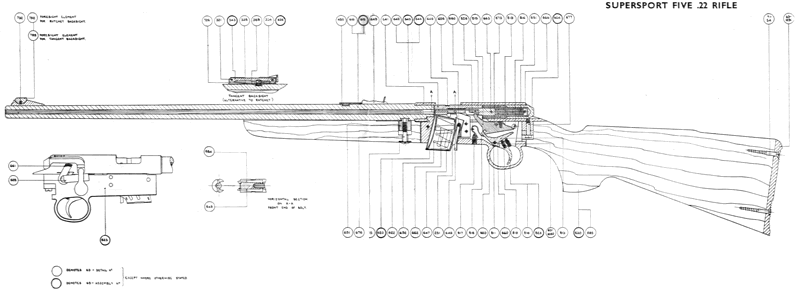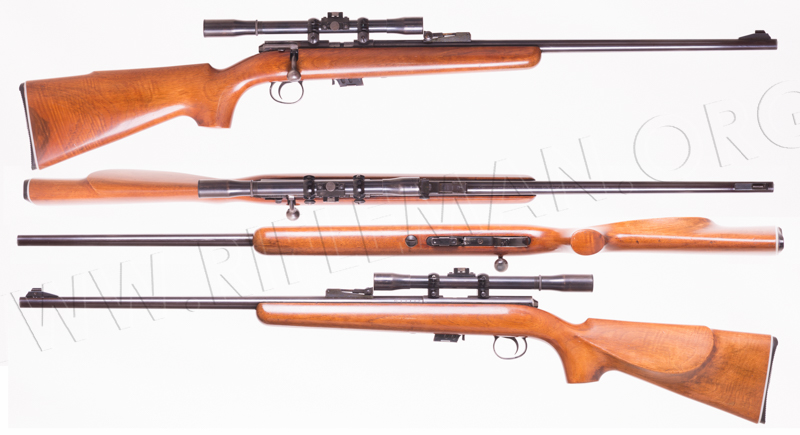The BSA SPORTSMAN & SUPERSPORT RIFLES
Please be aware that some specialist imagery may take time to load.
This site is designed for dedicated researchers, and is best viewed on desktop.
These rifles do not, strictly speaking, come under the military and target rifle remit of this website. However, they represent such a significant part of British, and particularly BSA, small-bore rifle history that we could not fairly dismiss them without comment. We have already afforded space to three other notable BSA sporting .22 calibre rifles, including the earlier BSA slide-action or "pump-action" repeating rifles and the semi-automatic BSA Armatic rifle, and must cover the more prolific production of the Sportsman range. The third example, the Ralock, is mentioned in a following paragraph.
Please note that dimensions and weight details of each of the rifles
are included in the various advertisement PDFs on this page.
The first 'Sportsman' rifle, introduced in 1947, was single shot, and effectively a Model No.3 rifle,
with modifications to the bolt-action, which rifle dated back to 1939.
The single-shot Sportsman model shown here has had
the pressed steel barrel-mounted "V-notch" open rear-sight removed,
a Parker-Hale Model 16 aperture sight fitted to the receiver, and a PH FS22 tunnel fore-sight added.
It has obviously been modified for target shooting,
which modification has resulted in something of a poor-man's BSA Century,
perhaps showing a degree of foresight of another kind.
These rifles were now marketed under the new company name of B.S.A. Guns Ltd.
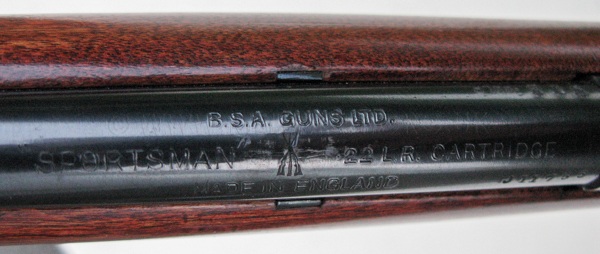
The action is here shown from above with the bolt withdrawn into the loading position.
The Parker-Hale Model 16 rearsight is in the fold-away position which,
had the barrel mounted rear-sight not been removed, would have permitted its use.
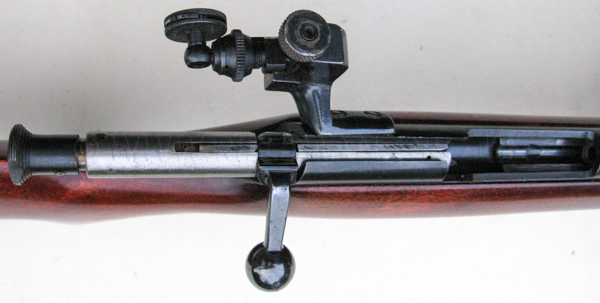
The heritage of this bolt, with its swivelling handle on the one-piece body, clearly lies with that of the BSA Model No.1 rifle that was quoted by the Society of Miniature Rifle Clubs as being ideal for "Ladies and Boys of 12 years of age or more", as it was light in weight at 4lbs 1½ozs., and just 37½ inches overall in length.
The Sportsman entered the scene at 42¾ inches overall, and 5lbs. 4ozs. in weight.

The Sportsman bolt is therefore both larger in diameter and longer than that of the Model 1, but the rotating handle is of the same design applied to the later production of the Model 1; the earlier bolt having been akin to that of the War Office 1906 Pattern Miniature Rifle.
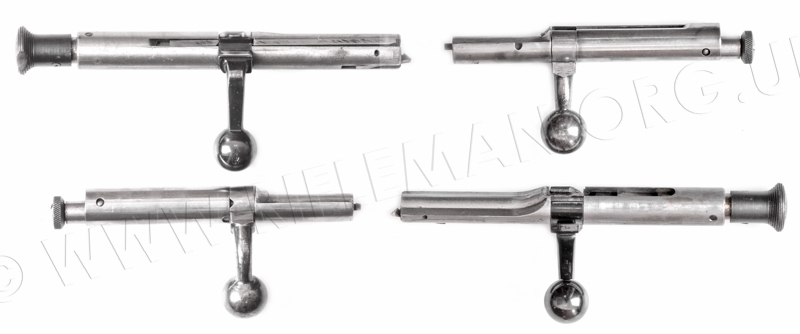
There are other differences, and the bolt faces are shown below.
Right: the firing pin of the Model 1 is contained and cylindrical resulting in an offset cocking-piece.
Left: the firing pin of the Sportsman is the new flat design located only by the "C" of the bolt handle.
The extractors are similar, but not identical.

This configuration remained until the introduction of the Supersport models,
with their more usual rotating bolt design in which the handle was integral with the body.
Below: the disassembled Sportsman single-shot rifle.
It is worth noting that the BSA Ralock semi-automatic sporting rifle,
with its unusual radial action, was itself introduced in the last quarter of 1947.
This was a busy year for the Birmingham Small Arms Company post-war;
indeed it also saw the introduction of a new target rifle, the Model 12/15,
which was a metamorphosis of the much earlier 'famous' Model 12 and pre-war Model 15 rifles.
Progression of the Sportsman range was unusually rapid.
The Sportsman Five repeating model theoretically came onto the market but one year later, in 1948;
this was the five-round box-magazine version.
It is shown both with and without a contemporary telescopic sight.
Below: the Sportsman Five rifle disassembled.
The March 1949 issue of the National Small-bore Rifle Association's journal "The Rifleman"
carried an article covering the Sportsman Five rifle written by the then well-known author and rifle shot A.G. Banks.
Below is a facsimile of the piece.
Whether it had a bearing on the development of the tubular magazine models is uncertain, but the box magazine model had a reputation for the unwanted release of the magazine, a problem apparently due to the release latch being a part of the magazine rather than a component of the rifle in the magazine-way. But whatever the reason, this system had been used fairly successfully on previous models, although the magazine's employment on the Lee-Enfield .22 No.5 trials rifle,the .22 No.6 trials rifle, and particularly the Rifle No.7 training version for the Royal Air Force, had had any such problem obviated by the inversion of the latch, with the magazine being fitted downwards into the modified Lee-Enfield magazine shell's shelf plate from the top.
Without doubt, the main reason for producing the tubular magazined Sportsman rifle was the demand for a greater magazine capacity. Although this could perhaps have been more simply achieved by lengthening the box magazine, its additional protrusion from the rifle may have been considered not ideal for the use of the rifle in the field; the tube design maintaing a sleeker line.
It is interesting, and unsurprising, to note that no small-bore rifles whatsoever were advertised
by Parker-Hale in their 1945 catalogue at the end of the Second World War.
Their 1944 "abridged" catalogue had shown only accessories, including military adapters,
with the only rifle available being the obsolete Enfield No.3 service rifle; the Pattern '14.
The 1946 catalogue listed this, with the addition of just three civilian .22RF rifles
in company with their long-standing .22 converted S.M.L.E. Mk.III rifle.
The three were the new Vickers target rifles, the also new BSA Model 12/15,
and the comparatively elderly Parker-Hale CMT3 rifle -
- the conversion of the old full-frame Martini-Henry/Enfield rifle.
However, as if to directly contradict what has been indicated in existing documentation about these rifles,
the 1947 catalogue carried a page advertising not only the single-shot BSA Sportsman rifle,
but also both the Sportsman Five and Ten models. The three rifles were respectively priced at
six pounds, seven pounds ten shillings, and seven pounds seventeen shillings and sixpence.
The 1947 catalogue page is shown below.
The advertisement was repeated in practically identical form in the 1950 catalogue,
but references to optional Sportarget sights were added at the bottom of each page. The prices remained the same.
The trade prices for the three rifles at that time were respectively five pounds twelve shillings,
six pounds seven shillings and sixpence, and six pounds thirteen shillings and eleven pence.
(N.B. There were twenty shillings to the pound, and twelve pennies to the shilling;
i.e., 240 pennies to the pound. A shilling equates to 5 decimal pence.)
Below is an invoice from B.S.A.Guns Ltd.,
as these rifles were by then no longer manufactured by the original Birmingham Small Arms Company.
The invoice was for a Sportsman Five rifle that had been sent in July 1949 to the dealers G.E. Lewis and Sons,
also of Birmingham, showing the retail price of seven pounds and ten shillings, with the trade discount of 25%.
The final cost was five pounds, twelve shillings and sixpence - before purchase tax.
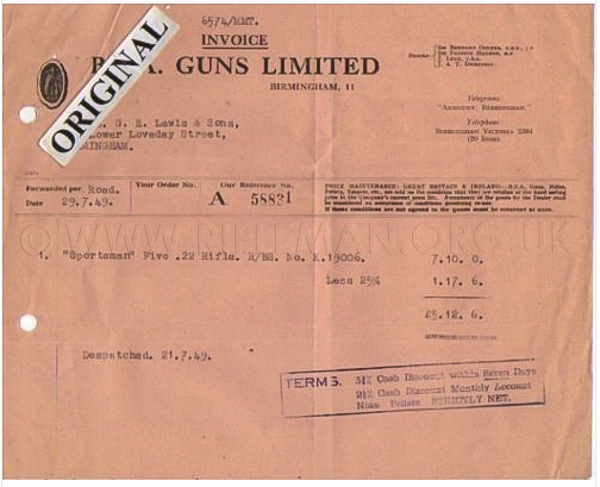
Plans to increase ammunition capacity must have been on the drawing-board from day one,
probably in view of the competition from the U.S.A.,
because the magazine-fed Sportsman Five and the Sportsman Ten,
the latter with its tubular magazine under the barrel à la some ubiquitous Winchesters,
came into being very soon after the launch of the single-shot model.
The rarest Model Ten is shown below.
And in disassembled form.
It took only until the following year
for the tubular magazine capacity to be increased by fifty percent,
with
the supercession of the Sportsman Ten by the Sportsman Fifteen.
The Sportsman Ten was only advertised in the Parker-Hale catalogues between 1947 and 1950,
but a leaflet was produced by BSA that showed it included in the "New" range of rifles early in the period.
It affords a basic rundown on the configurations of the three models.
There was a cleverly composed BSA Guns contemporary advertisement for the whole new range.
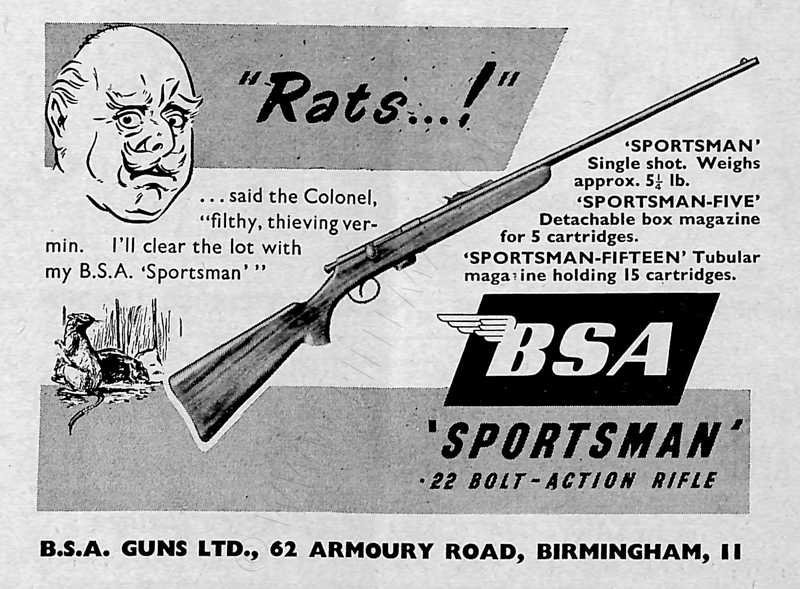
In 1951, the three models of Sportsman rifles in the Parker-Hale catalogue were shown on two pages,
with options for alternative sights.
By 1953, the Parker-Hale catalogue entries remained as two adjacent pages, 134 and 134A, with the first covering the range of rifles and the basic single shot model, and the second offering an option for a 2¼ X magnification telescopic sight with coated lenses - shown on a Sportsman Five. The previous alternative iron sights were again available, and there was an additional option of a moderator.
A printer's requirement presumably, the next page, 134B, covered .22 BRNO sporting rifles,
and page 135 opposite covered the Sportsman Five and Fifteen models,
(shown out of sequence below between the first two pages).
The competing Alfred J. Parker ca. 1956 advertisement for the rifles, including the Supersport, was allotted just the one page.
The single page 1957 Parker-Hale advertising advised that all stocks of the Five shot model had been exhausted,
but that sufficient remained to maintain supplies of the Single-shot and Sportsman Fifteen 'for some time to come".
John Knibbs, in his comprehensive book of BSA civilian rifle production*, describes the Sportsman Fifteen
as "perhaps the most successful .22 calibre sporting rifle ever produced by BSA".
He quotes the total production figures for the various models as follows:
Sportsman Single: 33,434 between 1947 and 1955
Sportsman Five: 58,534 between 1948 and 1955
Sportsman Ten: 9,854 between 1949 and 1950
Sportsman Fifteen: 53,247 between 1950 and 1955**
Supersport Five: 7,197 between 1955 and 1967
These figures are probably correct in terms of production quantities,
but there is doubt in respect of the years quoted, in the light of the contemporary advertising.
This obviously also applies to the table below, compiled from the book's statistics.
The only way in which dates could be confirmed would be by means of any Proof House
date stamps, usually beneath the woodwork under the barrel.
Details of how to check this are to be found on our Date your Rifle page;
but this mark is not always present, as B.S.A. had their own approved proofing facility
that stemmed from wartime necessity.
THE SPORTSMAN FIFTEEN
With its obviously longer magazine tube for fifteen Long Rifle .22 cartridges,
The rifle is shown with tall 'scope mounts to raise a more modern telescopic sight
with larger diameter objective lens bell so that it clears the ratchet fore-sight.
Sadly the 'scope did not come with the rifle, so we cannot tell its type.
Below: the contemporary Maintenance Instructions for the Sportsman 5, 10 & 15 rifles.
This is in the form of a text-searchable flip-page document that may take a few moments to load.
Double tap tablet or click ![]() for full page display.
for full page display.
THE SUPERSPORT FIVE
A classic example of a well-used basic rifle with its original ratchet rear-sight.
The staining at the rear of the butt bears witness to a once fitted rubber 'recoil reducing' pad,
more likely to have been used as an anti-slip and/or butt extending feature.
Click image for the full original size drawing of the Supersport Five
A contemporary leaflet for the Sportsman Five is shown below.
And the following advertisement just one year later was solely for the Supersport Five,
and this one page Parker-Hale advert remained the same from 1958 through to 1962.
Below: a 'scoped version of the Supersport Five.
This is a fine example that has evidently been extremely well cared for, and perhaps little used.
It has been fitted with the optional BSA windage adjustable tangent rear-sight
calibrated for 50, 100 and 200 yards as shown in the brochure above.
The Monte Carlo style butt was a feature of the Supersport rifles not seen on the earlier models.
The ribbed vulcanised rubber butt-plate with white trim plate
was probably a later addition by the rifle's careful owner.
John Knibb's book is to be recommended to those who wish to research in greater detail,
including engineering design, and particularly with respect to serial numbers and their relationship to production dates.
An approximate guide to the date of manufacture of a Sportsman or Supersport rifle
is afforded by the table below.
DATA TABLE - BSA SPORTSMAN .22 RIMFIRE RIFLES |
||
BSA RIFLE MODEL |
DATES of MANUFACTURE |
SERIAL No.. PREFIX |
| Sportsman Single-Shot Bolt Action | 1947 - 1950 |
J |
| Sportsman Single-Shot Bolt Action | 1953 - 1955 |
J |
| Sportsman Single-Shot Bolt Action | 1950 - 1951 |
JA |
| Sportsman Single-Shot Bolt Action | 1951 - 1952 |
JB |
| Sportsman Single-Shot Bolt Action | 1952 |
JC |
| Sportsman Single-Shot Bolt Action | 1952 - 1955 |
JD |
| Sportsman FIVE Bolt Action | 1950 - 1952 |
KA |
| Sportsman FIVE Bolt Action | 1951 |
KB |
| Sportsman FIVE Bolt Action | 1951 - 1952 |
KC |
| Sportsman FIVE Bolt Action | 1951 - 1955 |
KD |
| Sportsman TEN Bolt Action | 1949 - 1950 |
L |
| Sportsman FIFTEEN Bolt Action | 1950 - 1954 |
LA |
| Sportsman FIFTEEN Bolt Action | 1951 |
LB |
| Sportsman FIFTEEN Bolt Action | 1951 |
LC |
| Sportsman FIFTEEN Bolt Action | 1951 |
LD |
| Sportsman FIFTEEN Bolt Action | 1951 - 1955 |
LE |
| Supersport FIVE Bolt Action | 1955 |
S |
| Supersport FIVE Bolt Action | 1955 - 1958 |
SA |
| Supersport FIVE Bolt Action | 1955 - 1966 |
SB |
| Supersport FIVE Bolt Action | 1966 - 1967 |
SC |
By 1959 the prices for the Supersport Five rifle, the only model listed,
were £15.00 with the cheaper ratchet rear-sight and a pound more with the tangent sight.
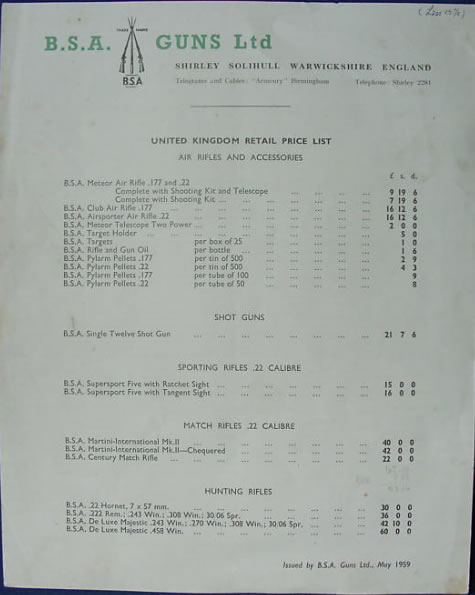
Below: the contemporary advertising leaflet for the Supersport 5 rifle.
This is in the form of a text-searchable flip-page document that may take a few moments to load.
Double tap tablet or click ![]() for full page display.
for full page display.
As a matter of marginal interest in the subject of this page,
their rifles were not the only BSA Sportsman product.
The name was also applied to their 350cc motorcycle, advertised as below for the U.S.A. in 1961.
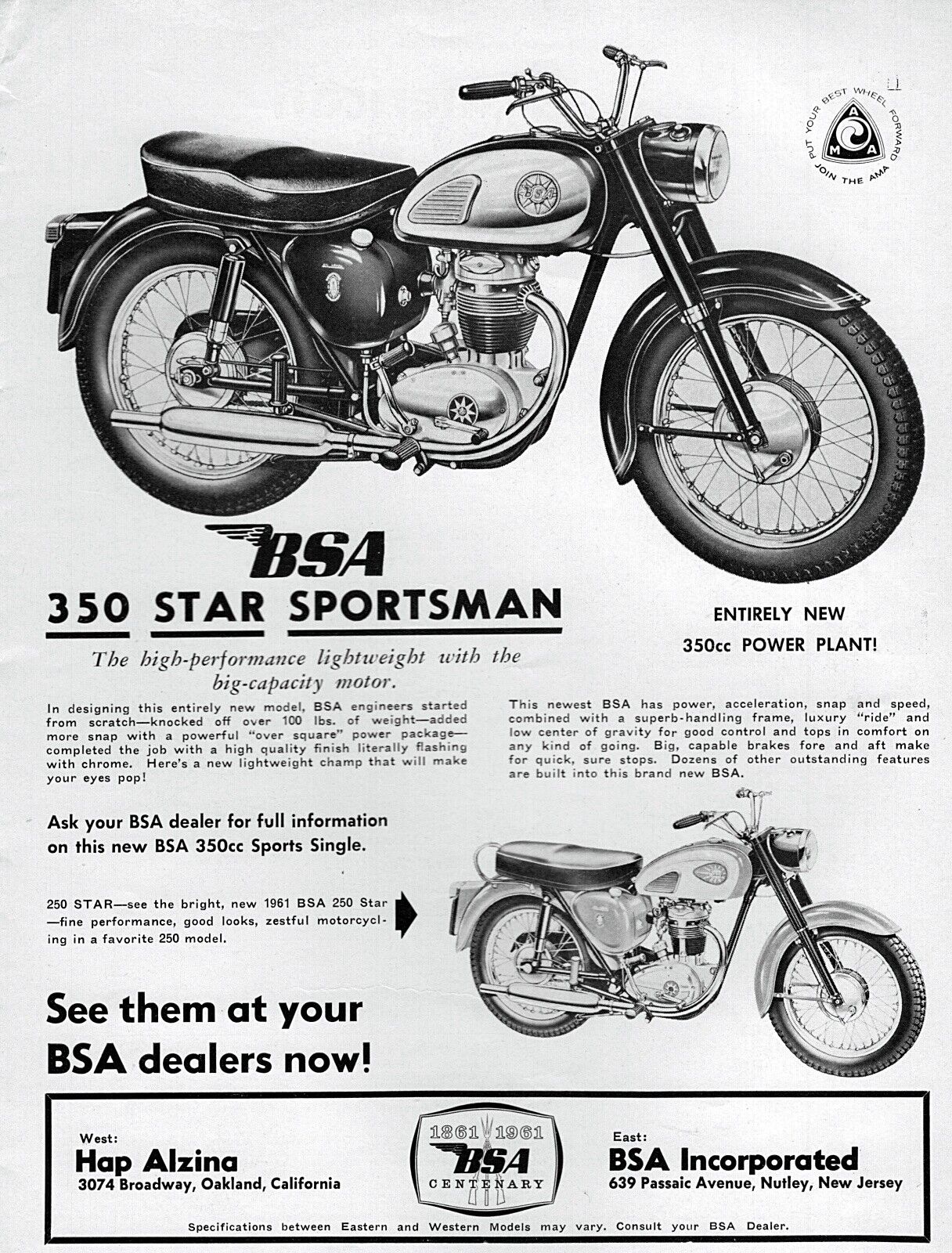
More on military bicycles, including BSA Models, can be found HERE.
See also - more pages on BSA and other smallbore rifles.
* "BSA - The Golden Century" .............. see Bibliography
** Compare this figure with the total production of the Model 12/15 target rifle at 18,662
Return to: TOP of PAGE
See this website's Raison d'être
